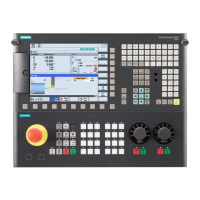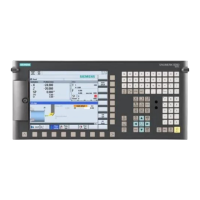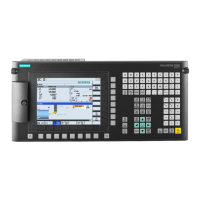Programming and Operating Manual (Turning)
01/2017
147
Cycles are generally applicable technology subroutines that you can use to carry out a specific machining process, such as
tapping. These cycles are adapted to individual tasks by parameter assignment.
Drilling cycles and turning cycles
You can carry out the following standard cycles by using the control system:
●
CYCLE81: Drilling, centering
CYCLE82: Drilling, counterboring
CYCLE83: Deep-hole drilling
CYCLE84: Rigid tapping
CYCLE840: Tapping with compensating chuck
CYCLE85: Reaming 1
CYCLE86: Boring
●
CYCLE92: Cut-off
CYCLE93: Recess
CYCLE94: Undercut (DIN form E and F)
CYCLE95: Stock removal with relief cutting
CYCLE96: Thread undercut
CYCLE98: Thread chain
CYCLE99: Thread cutting
A standard cycle is defined as a subroutine with name and parameter list.
Call and return conditions
The G functions effective prior to the cycle call and the programmable offsets remain active beyond the cycle.
The machining plane G17 for drilling cycles or G18 for turning cycles is defined before calling the cycle.
With drilling cycles, the drilling operation is carried out in the axis standing vertically to the current plane.
Messages output during execution of a cycle
Messages about the state of machining are displayed on the screen of the control system during program execution.
These messages do not interrupt the program execution and continue to be displayed on the screen until the next message
appears.
The message texts and their meaning are listed together with the cycle to which they refer.
Block display during execution of a cycle
During the cycle execution, the cursor is always located on the program blocks of the cycle.
Cycle call and parameter list
The defining parameters for the cycles can be transferred via the parameter list when the cycle is called.
Note
Cycle calls must always be programmed in a separate block.
